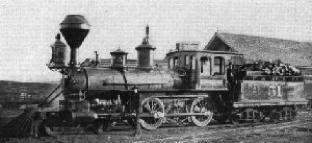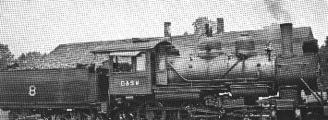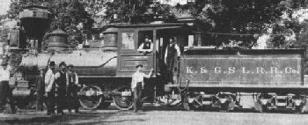As with many early railroads, financial problems beset the Tyler Tap. In 1879, Douglas went to St. Louis and talked to a group of investors about his railroad. This group was headed by James W. Paramore who owned and operated the St. Louis Cotton Compress Company. These men had been looking for a way to ship their Cotton into Texas and on May 17, 1879, The Texas and St. Louis Railway was organized. This new railroad would stretch from St. Louis to Texarkana and connect with the Tyler Tap which was to be extended to Texarkana from the south. By 1880, the new railroad had purchased five new 24-ton locomotives, four new passenger cars and one hundred new freight cars. They would expect the road to be finished all the way to Waco, Texas, by 1881.


St. Louis Southwestern Railroad History
Since 1919 the Cotton Belt had been a very important connection of the Southern Pacific system on traffic between points in the East and the Pacific Coast and points in Texas. The consolidation and strengthening of other systems in the Southwest during the decade, 1920-1930, brought the Southern Pacific to a realization that self preservation required a route to this competitive territory. In July, 1930, the Southern Pacific filed an application with the Interstate Commerce Commission seeking authority to acquire control of the Cotton Belt through ownership of a majority of its capital stock, part of which had been purchased and part of which was under conditional Purchase at that time.
Tyler Tap Railroad
Texas & St. Louis Railway
St. Louis, Arkansas & Texas Railway
Little Rock and Shreveport Branches
This was the first link in the STLSW Railroad in 1877 near Tyler Texas. The people of Tyler had hopes of being located on the main line of the International & Great Northern Railroad, but as it was surveyed to Longview by the way of Troup, the citizens decided to promote and construct a railroad to tap either the Texas & Pacific or the International. In charge of this scheme was a young army officer, Major James Postell Douglas. Upon returning home to East Texas after the War Between the States, Major Douglas became interested in the fruit industry. Needing a means of rapidly shipping this commodity outside the production area, he petitioned the Twelfth Legislature of Texas in 1870 to pass a special act of incorporation granting to him and others the right to locate, construct, own, operate, and maintain a
The reorganization of the Texas and St. Louis into the St. Louis, Arkansas and Texas was accomplished when the special bondholders' committee deeded the property of the Texas company to the St. Louis Arkansas & Texas Railway Company in Texas on February 11, 1886, and the Arkansas and Missouri company to the St. Louis, Arkansas & Texas Railway Company in Arkansas and Missouri on April 29, 1886. Two companies were necessary, as before, to comply with Texas laws, but in fact only one management existed. Fordyce remained the receiver of the old company until May 1, 1886, on which date he became president of the new company. Paramore dropped out of the organization, but continued to hold a majority of the securities. Shortly, however, he became alarmed when the bankers, Kuhn, Loeb and Company, began to dispose of their holdings, and at his death in 1887, he had no connection with the company. The officers of the railroad then decided that it would be necessary to change to standard gauge rail and on October 18, 1886 the work began.
The first of these companies was the Little Rock and Eastern Railway, which was incorporated February 17, 1887, under the laws of the state of Arkansas in the interest of the Arkansas and Southern Railway Company for the purpose of constructing a line from Altheimer to Argenta, (now North Little Rock), Arkansas, approximately forty-one miles long. On August 15, 1887, before any construction work had been done, its rights and franchises were conveyed to the latter company
On August 13, 1887, before any construction work was done, the Shreveport and Arkansas Railway Company conveyed its right to construct a line from the city of Shreveport, Louisiana, to the Arkansas state line, in the general direction of Lewisville, Arkansas, to the Arkansas and Southern Railway Company, The Shreveport and Arkansas Railway Company was incorporated on May 18, 1887. Learn more.
Short Line Railroads Absorbed by Cotton Belt
Little River Valley & Arkansas Railroad (Purchased 1881)
The oldest company to become a part of the Cotton Belt dates back to 1855. The Little River Valley & Arkansas Railroad (27-mile route), which operated a narrow gauge line from New Madrid to Maiden, Missouri, began as the New Madrid and West Prairie Road Company on February 22, 1855. The Little River Valley owned two locomotives, two passenger cars, and thirty freight cars. Learn more.
A fascinating twist in the Cotton Belt’s history occurred when Tyler Tap founder James P. Douglas started a new railroad, also in Tyler, Texas, for the same purpose, to provide rapid transportation for his business interests. He shepherded construction and development of the Tyler Tap until he was assured that outside investors would guarantee its completion. He resigned, and on February 18, 1880, incorporated the Kansas & Gulf Short Line. It would be a three-foot-gauge line built from Tyler south to Sabine Pass, Texas, on the Gulf of Mexico. If the Gulf couldn't be reached, connections were available at Jacksonville with the International & Great Northern or at Lufkin with the narrow gauge Houston East & West Texas. Learn more.
Kansas & Gulf Short Line/Tyler Southeastern Railroads (Purchased 1899)
The Stuttgart & Arkansas River, extending east and south from the Cotton Belt main line at Stuttgart, north of Pine Bluff, a distance of 35.47 miles, was incorporated on November 21, 1888. The first section, to DeWitt, was finished in 1888-89, while the remainder, south to Gillett, was completed in 1892, at a total cost of $250,000. Within a few months after opening for business, the S&AR's debt exceeded its earning capacity, and a receiver--the Cotton Belt's S.W. Fordyce--was appointed by the bankruptcy court on January 27, 1893. As an independent line, the S&AR never made a profit, and on January 3, 1901 was sold to the Cotton Belt in order to settle claims of creditors.
Stuttgart & Arkansas River Railroad (Purchased 1901)
These two railroads formed the Lufkin and Dallas Branches of Cotton Belt. The lumbering country of east Texas was within reach of Lufkin, the far southern extension of the Cotton Belt. In the first decade of the Twentieth Century, the territory between the Trinity and Sabine Rivers was undergoing intensive development, with the largest pine lumber mill of all being built at Kennard, some thirty miles west of Lufkin.
Texas & Louisiana Railroad (Purchased 1903)
and Eastern Texas Railroad (Purchased 1906)
Incorporated May 18, 1901, the original goal of the Central Arkansas & Eastern was to build a rail line from England (on the Cotton Belt's branch line to North Little Rock) due east to Ryan. Soon, the promoters sought to expand further east to Stuttgart and north from Rice Junction to Hazen, but the CA&E itself was only able to construct nine miles of track linking the towns of England and Ryan before the Cotton Belt stepped in on July 1, 1910. The railroad was used mainly for hauling rice, lumber and hay. Learn more.
Central Arkansas & Eastern Railroad (Leased 1910)
For less than three decades, from 1913 to 1941, the Cotton Belt operated rail lines west of Gatesville, Texas, its historical far western frontier, through the agency of the Stephenville North & South Texas. Learn more.
Stephenville North & South Texas Railroad (Leased 1910)
Extending generally eastward from Paragould, Arkansas, into the farming and lumbering area of the St. Francis Basin, a small narrow gauge railroad was built during 1887. This was the Paragould & Buffalo Island Railway, incorporated October 11, 1887. About eight miles were built, and the principal business at the time was provided by the Ware-Rossen Stave Mill at Paragould. Only one locomotive was originally needed, a secondhand machine named Cassie. Learn more.
Paragould Southeastern Railroad (Purchased 1914)
Another narrow gauge property, the Pine Bluff Arkansas River, went through numerous title changes before being taken over by the Cotton Belt on January 1, 1918. It began as the Pine Bluff and Swan Lake Railway, incorporated on June 11, 1884, and constructed nineteen miles of narrow gauge southeasterly along the Arkansas River from Rob Roy in the fall of that year. The little line obtained trackage rights on the Texas & St. Louis down as far as Pine Bluff. A reorganization took place in November, 1884, resulting in formation of the Little Rock, Pine Bluff & White River, while only a month later the Pine Bluff; Monroe & New Orleans took over. This company boasted two engines on its roster, one of which was the former T&StL #20. It was reorganized again as the Pine Bluff & Eastern on July 18, 1892. In January, 1898, the Pine Bluff Arkansas River, took over, and immediately standard-gauged the existing nineteen miles. The entire line was abandoned in December of 1934. Learn more.
Pine Bluff Arkansas River Railroad (Leased 1918)
In 1928 the St. Francis Basin Project was commenced. The purpose was to gain access to the rich and very productive territory in Southeast Missouri and Northeast Arkansas by purchasing several small railroads that were already operating in that section. There were six small railroads involved: the Gideon and North Island, the Deering Southwestern, the Blytheville, Leachville and Arkansas Southern, the Cairo, Trumann and Southern, the Manila and Southwestern, and the Arkansas Short Line. Thirty miles of new construction were required to make connection into Memphis. Cotton Belt freight trains operated over tracks of the Missouri Pacific until November 9, 1935, between McDonald and Briark, Arkansas, in transporting traffic into and out of Memphis, Tennessee. The line between Trumann and McDonald, Arkansas, was abandoned in January, 1946.
The St. Francis Basin Project (1929-1930)
The Northernmost of the lines was the Gideon & North Island, a logging road incorporated April 30, 1908. Its 56-pound rail extended five and one-third miles southeastward from the Cotton Belt main line at Maiden, Missouri, to the town of Gideon. For its first two decades of existence, the G&NI was owned by the Gideon-Anderson Lumber Company, which operated a sawmill at its southern terminus. For $80,000, the Cotton Belt obtained the main line of the Gideon & North Island, plus a right-of-way toward Deering. The lumber company retained more than ten miles of logging trackage fanning out from Gideon, as well as the G&Nl's roster of locomotives, which held no great appeal for the Cotton Belt. Over 131,000 Cotton Belt dollars were spent reconstructing the G&NI during the next two years.
Gideon & North Island Railroad
Approximately 19 miles to the south of Gideon were the rails of the Deering Southwestern Railway, next in the project. The DSW trackage originated at Caruthersville, Missouri (on the Mississippi, and extended almost due west to Deering, where it veered southwest to Hornersville and connected with the Cotton Belt. A connection with the Frisco was made at Blazer. The International Harvester-controlled Wisconsin Lumber Company had incorporated the DSW on June 24, 1903, with the first trackage from the mill at Deering to Hickory laid that year; the rest of the road was completed in 1910 and 1911. Logging rapidly dropped off after 1925 & as fast as forest was cleared, cotton was planted, destined for market at Memphis.
Deering Southwestern Railroad
The longest and most complex of the St. Francis Basin acquisitions was the Blytheville, Leachville & Arkansas Southern Railroad, which provided the next nineteen miles of existing rail line, south from Leachville, Arkansas to the small town of Riverdale. The BL&AS was part of the Chicago Mill & Lumber Company, and was organized May 18, 1908. Its sponsor was the largest single shipper in the Basin and since 1914, the BL&AS had negotiated more than eighty miles of trackage rights on both competing roads into the mill town of Blytheville, via the Frisco from Leachville, and north from there on the Frisco to Arbyrd, where the rails of the Cotton Belt ( Paragould Southeastern) were picked up.
Blytheville, Leachville & Arkansas Southern Railroad
Another nine miles of new construction directly west from Caraway Junction brought the line to Lunsford, where some of the right-of-way of the Manila & Southwestern was put to use. The M&SW had been incorporated March 28, 1904 to build a railroad from Herman (northwest of Trumann on the Frisco) east and then north to Lunsford. By 1929, such business had all but evaporated, and for $20,000 the Cotton Belt acquired a few pieces of land while the M&SW went out of business.
Manila & Southwestern Railroad
A branch of the Tschudy Lumber Company, the CT&S was incorporated on February 7, 1912, and built a lumber road southwesterly from Trumann, some eighteen miles to Weona. The line was operated by at least five Heislers and a former Pittsburgh & Lake Erie 4-6-0, all bought between 1912 and 1924. The Cotton Belt took over the line-haul business of the CT&S, & on a different route slightly to the west, and reimbursed its owners $200,000 so they would abandon most of the CT&S line.
Cairo, Truman & Southern Railroad
The final 31.7 miles of line, between Trumann and McDonald, were originally constructed by the Arkansas Short Line, which had been incorporated May 17, 1922 by the Poinsett Lumber and Manufacturing Company, a subsidiary of the Singer Manufacturing Company, which owned a plant at Trumann. For $600,000, the Cotton Belt acquired this trackage, but no engines were involved. Poinsett Lumber owned a large roster of its own, and maintained a number of rail logging operations in the state.
Arkansas Short Line Railroad
After the property was involved in its second receivership, the reorganization of the St. Louis, Arkansas & Texas inaugurated the organization of the St. Louis Southwestern Railway Company, which was incorporated in Texas on January 12, 1891, and in Missouri on January 16, 1891. Louis Fitzgerald, acting purchasing agent for the reorganization committee, had bought the Texas property at foreclosure on January 8, 1891, and deeded it to St. Louis Southwestern Railway Company of Texas on January 13. The Arkansas and Missouri property was bought at foreclosure on October 20, 1890, and deeded to St. Louis Southwestern Railway Company on February 9, 1891. The narrow-gauge Lufkin branch, which was formerly the Kansas and Gulf Short Line and had been operating independently since its acquisition by the St. Louis, Arkansas and Texas Railway in 1887, was sold to Fitzgerald on January 9, 1891, and four days later was conveyed to the newly incorporated Tyler Southeastern Railway Company. All three of these properties were operated by the receivers until June 1, 1891, on which date the new companies took Possession and began operations. The St. Louis Southwestern owned the stock of the other two companies, and managed and financed all three as one system, although the Texas companies were operated separately.
St. Louis Southwestern Railway
Southern Pacific Takes Control

railroad. It would own a single or double track for a distance not exceeding 40 miles from Tyler to connect with some other railroad, to be selected by the directors. His request was granted on December 1, 1871. This was a narrow-gauge line of 3 feet and operated with one small locomotive. Learn more.

After receiving permission for his Railroad to run in Arkansas and Missouri, Paramore began looking for someone in Arkansas to help with the Arkansas end of the venture. He had served in the Civil War with a young Cavalry officer named Samuel W. Fordyce of Hot Springs, Ar. who had won the esteem of his fellow officers. Fordyce accepted the offer to help locate the railroad in Arkansas and Fordyce began ridding from one end of the state to the other searching for a suitable route. It had been previously decided to use the narrow three-foot gauge rail since Paramore believed it would be more economical and there would not be a need for large freight cars since they would be hauling mostly Cotton. Fordyce finally decided on a route and after talking to land owners, rode three more times over the route which would take the line through Texarkana, Camden, Pine Bluff, Clarendon, Jonesboro, and Birds Point, Mo. Birds Point was located just below Cairo, Il. on the Mississippi River. The cost of the right-of-way through Arkansas was $75,000.
In the summer of 1881, construction was started in several places at once in order to minimize chances of delay because of inclement weather. The rails were imported from Wales and brought to the port at New Orleans, then shipped up the Mississippi River to Bird's Point. The rail weighed 35 lbs. per yard and cost approximately $75.00 per ton delivered. White oak was used for the ties since it was easily obtained. One of the most remarkable features of this railroad was the number and length of bridges that were required.
• Rob Roy at the Arkansas River - 1587 foot draw bridge
• Red River Bridge - One half mile long
• White River Bridge & trestle - Four miles long
• Ouachita River Bridge - 225 feet long with one and one quarter mile trestle
• Saline River Bridge - 150 feet long with three quarter mile trestle
The section between Pine Bluff and Clarendon was mostly swamp land infested by mosquitoes and suffered significant delays because many workers contracted malaria. On August 12, 1883, the line between Bird's Point, Missouri to Gatesville, Texas was completed and a celebration was held at Rob Roy on the Arkansas River Bridge near Pine Bluff. There, two trains met on the bridge and Mr. Paramore drove the silver spike to mark the occasion. Learn more.
Narrow-gauge wood burner #51 was built by
Grant Locomotive Works in 1882 and converted
to standard gauge at Tyler Shops in 1889

Since 1919 the Cotton Belt had been a very important connection of the Southern Pacific system on traffic between points in the East and the Pacific Coast and points in Texas. The consolidation and strengthening of other systems in the Southwest during the decade, 1920-1930, brought the Southern Pacific to a realization that self preservation required a route to this competitive territory. In July, 1930, the Southern Pacific filed an application with the Interstate Commerce Commission seeking authority to acquire control of the Cotton Belt through ownership of a majority of its capital stock, part of which had been purchased and part of which was under conditional Purchase at that time.
The ICC's proposed report, which was favorable to the plan, suggested an offer for the acquisition of minority stock. Acting on this suggestion, the Southern Pacific offered to exchange its stock for St. Louis Southwestern stock in the ratio of one share of Southern Pacific stock for three shares of St. Louis Southwestern common, and three shares of Southern Pacific stock for five shares of St. Louis Southwestern preferred. The offer was conditioned on acceptance by a sufficient number of minority stockholders to increase the Southern Pacific's holding to 85 per cent of the total outstanding shares.
The final order of the ICC approved the plan upon conditions which the Southern Pacific accepted in February, 1932. On April 14, 1932, the Southern Pacific Company purchased the stocks which had been in escrow, and on April 19, the same year, it issued sufficient amounts of its own stock to exchange for deposited St. Louis Southwestern stocks in order to complete its control of the Cotton Belt. By May, 1933, the Southern Pacific had 193,134 shares of St. Louis Southwestern preferred and 130,834 shares of St. Louis Southwestern common or 87.37 per cent of the total outstanding shares of Cotton Belt stock.

Baldwin #8, Deering, Missouri in 1929

Kansas & Gulf Short Line Locomotive #4 - 1880
